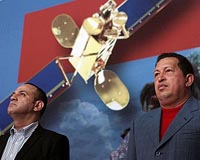 |
Bonn, Germany (SPX) Nov 03, 2009 The first German satellite, AZUR, was launched 40 years ago. On 8 November 1969 at 02:52 Central European Time (CET), which was 7 November at 17:52 Pacific Standard Time (PST), a four-stage American Scout-B rocket took off from the launch site at Vandenberg Air Force Base in California - with Germany's first scientific spacecraft on board. The successful launch and operation of AZUR was a great technological advance for German space research and turned Germany into a space-faring nation - until then, only the Soviet Union, the USA, France, Great Britain, Italy, Canada, Japan and Australia had their own satellites. AZUR - also known as 'German Research Satellite-1' (GRS-1) - had a mass of 72.6 kilograms, a length of 115 centimetres and a diameter of 66.2 centimetres. It was placed in a highly elliptical polar orbit - the nearest point to Earth (perigee) of its orbit was 391 kilometres from the Earth, while its furthest point from Earth (apogee) was 3,228 kilometres. AZUR's orbital inclination with respect to the Equator was 102.9 degrees and each orbit took 122.7 minutes.
A relatively short but successful excursion into space AZUR was also used to conduct research into the Aurora Borealis (northern lights) and the variation in solar wind during solar eruptions. On 29 June 1970, for unknown reasons, the connection to AZUR was lost. It is assumed that radiation damaged the data transmission system. Although the planned service life of one year was not reached, instead lasting just 233 days, the project was nonetheless seen as a great scientific and technological success for Germany - the country had taken its first step into space. Share This Article With Planet Earth
Related Links German Aerospace Center (DLR) Space Technology News - Applications and Research
 Venezuelan President Celebrates First Anniversary Of Satellite Launch
Venezuelan President Celebrates First Anniversary Of Satellite LaunchCaracas (XNA) Nov 02, 2009 Venezuelan President Hugo Chavez celebrated on Thursday the first anniversary of Venesat-1 satellite's launch. During the ceremony, Chavez confirmed the Venesat-1's operability, denying the rumors of its falling into the sea or running off the orbit. The ceremony was held in the auditorium of CANTV, a state-owned telecom service company, which commenced its services through the ... read more |
|
| The content herein, unless otherwise known to be public domain, are Copyright 1995-2009 - SpaceDaily. AFP and UPI Wire Stories are copyright Agence France-Presse and United Press International. ESA Portal Reports are copyright European Space Agency. All NASA sourced material is public domain. Additional copyrights may apply in whole or part to other bona fide parties. Advertising does not imply endorsement,agreement or approval of any opinions, statements or information provided by SpaceDaily on any Web page published or hosted by SpaceDaily. Privacy Statement |